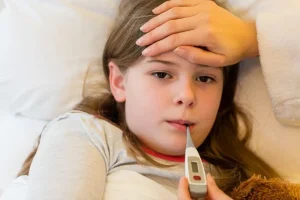Sleep is a crucial component of a healthy childhood, and chronic sleep disruption can lead to a range of behavioural, developmental, growth and cardiovascular health issues. Sleep disordered breathing (SDB) is a term used to describe abnormal respiratory patterns and function during sleep, including apnea (obstructive and non-obstructive), hypopnea and hypoventilation.
This article describes obstructive sleep apnea (OSA) which is the most common of SDB in children and adolescents. The prevalence of OSA in children is estimated to be between 1-5.7% in healthy children, but this number increases exponentially in children with conditions predisposing them to OSA, such as Down syndrome (75%), obesity (30-50%), those with ENT issues such as hay fever and/or sinus issues (25-50%), and conditions that affect the structure of facial bones or the airways (80%)1. Studies have repeatedly demonstrated complications of OSA. This include but is not limited to;
Neurobehavioral, Neurodevelopmental And/Or Neuropsychiatric
SDB has strong links to attention-deficit/hyperactive disorder, depression and developmental delay. Neuroimaging in children have identified changes in the cortical structures and function of the brain leading to neurobehavioral and neurodevelopmental issues. Children with such changes also demonstrated inferior scores in neurocognitive testing2. Behavioural regulation, attention, executive functioning, memory and processing speed have all been shown to be impaired in these children. Additionally, there has been evidence of the relationship between depression and OSA in children. However, neurocognitive outcomes have been shown to improve following the management of SDB.
Cardiovascular And Endocrine Complications
Emerging evidence point towards an increase in the baseline blood pressure in children with OSA. More importantly, children with unrecognised childhood OSA and elevated blood pressure continue to have elevation in their blood pressure into adulthood. Ventricular dysfunction and remodelling also begins in children suffering from OSA with emerging evidence of endothelial dysfunction. Over time, pulmonary hypertension and cor pulmonale may occur. In children with OSA, it has been found that insulin resistance is higher irrespective of their body mass index. Fortunately, a number of these life altering outcomes have been also shown to improve following the early management of OSA.
Socioeconomic Outcomes
The long-term effects of OSA in children extend into adulthood. Longitudinal follow-up studies have shown that children with unrecognised OSA had lower educational achievements, lower income, higher unemployment and an increase in overall welfare cost3.
Approach To OSA In Children
In a primary setting, parents may not always report concerns in regards to their child’s sleep. Therefore, it can be helpful to include a brief inquiry about their sleep habits during routine history taking with follow-up questions if there are any indications of sleep disturbances.
While snoring is a common occurrence during an upper respiratory tract infection (URTI), snoring more than three nights per week outside of a URTI context, along with issues related to school performance, behaviour, focus and daytime sleepiness, should prompt further investigations.
Other symptoms to look out for include pauses in breathing, laboured or heavy breathing, mouth-breathing, waking up with a choking sensation, restlessness, excessive sweating, elevating their head or sleeping with a hyperextended neck, frequent headaches in the morning and secondary enuresis.
Although enlarged tonsils may provide some indication of OSA, the size of tonsils is not strongly associated to its severity. Therefore, children with small tonsils may still have significant OSA particular if the exhibits other OSA-related symptoms. Indicators of OSA can also include elevated body mass index (BMI), malocclusion of teeth, polyps in their nose, a high arched palate, pectus excavatum, or signs of neuromuscular diseases.
In a primary care setting, screening tools can be used to detect OSA. While their diagnostic accuracy is limited, they can still be useful in identifying potential cases. Examples of such tools include BEARS Sleep Screening Tool (URL: https://www.medicalhomeportal.org/link/6492) or the Epworth sleepiness scale for children and adolescents (URL: https://www.morethantired.com/pdf/epworth-sleepiness-scale-children-adolescents.pdf ).
Polysomnography (PSG) remains the gold standard for diagnosing OSA. This specialised test involves the recording of various physiological parameters, such as cardiorespiratory function, electromyography (diaphragm, eyes), abdominal and thoracic movement, airflow, gas exchange, limb movement as well as the different stages of sleep derived from EEG. The American Academy of Sleep Medicine (AASM) criteria are used to score PSGs, with the apnea-hypopnea index (AHI) typically used to quantify the severity of OSA. An AHI of >5 obstructive events/hour usually warrants treatment and subsequent monitoring of symptoms.
The following figure provides a simplified suggestion on the steps to identify OSA, treatment option and monitoring of children with suspected OSA.
References
1. Singh J, Yeoh E, Castro C, et al. Polysomnography in infants with clinical suspicion of sleep-related breathing disorders. Journal of clinical sleep medicine : JCSM : official publication of the American Academy of Sleep Medicine 2022;18(12):2803-12. doi: 10.5664/jcsm.10222 [published Online First: 2022/08/13]
2. Mei L, Li X, Zhou G, et al. Effects of obstructive sleep apnoea severity on neurocognitive and brain white matter alterations in children according to sex: a tract-based spatial statistics study. Sleep medicine 2021;82:134-43. doi: 10.1016/j.sleep.2020.08.026 [published Online First: 2021/04/30]
3. Jennum P, Rejkjær-Knudsen M, Ibsen R, et al. Long-term health and socioeconomic outcome of obstructive sleep apnea in children and adolescents. Sleep medicine 2020;75:441-47. doi: https://doi.org/10.1016/j.sleep.2020.08.017







